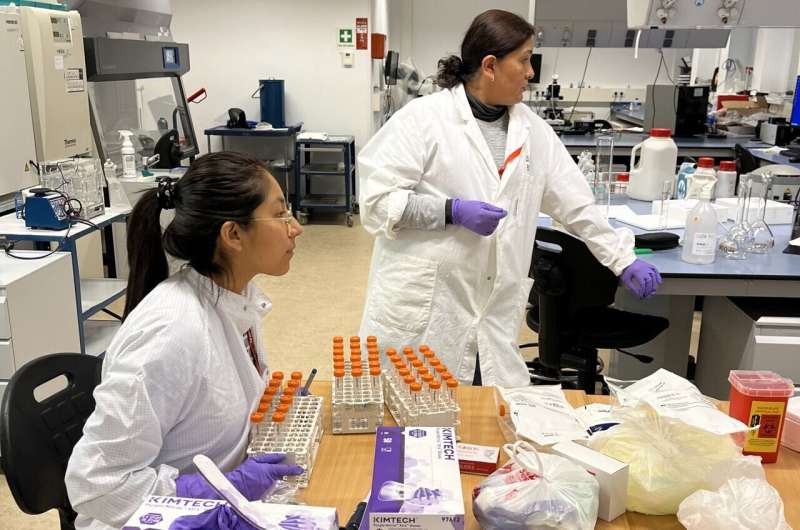The latest international group to employ ESA's hypergravity-generating Large Diameter Centrifuge is an all-female team from Bolivia, with access sponsored by the United Nations and ESA. The researchers are investigating whether the high gravity levels experienced during rocket launches might contribute to the anemia afflicting many astronauts in space.
Based at ESA's ESTEC technical center in the Netherlands, the LDC is an 8 m-diameter four-arm centrifuge that gives researchers access to a range of hypergravity up to 20 times Earth gravity for weeks or months at a time.
Access to the LDC was arranged through HyperGES, part of the Access to Space for All initiative sponsored by ESA and the United Nations Office of Outer Space Affairs, UNOOSA.
At its fastest, the centrifuge rotates at up to 67 revs per minute, with its six gondolas placed at different points along its arms weighing in at 130 kg, and each capable of accommodating 80 kg of payload.
The five-strong all-female team from Universidad Católica Boliviana "San Pablo" in La Paz, Bolivia, have spent two weeks studying the effects of hypergravity on red blood cells.
Astronauts are known to experience numerous adverse health effects while in space. Among them—observed since the earliest days of orbital flight—is anemia, which can cause dizziness and weakness.
Recent research shows this anemia is linked to "hemolysis," in which red blood cells are destroyed at a much higher rate than the usual recycling of old and damaged cells. This finding became the starting point for the team's research.
Team leader Dr. Georgina Chávez explains, "As part of a biology class I assigned a very simple task which many people might do in school: testing how osmosis affects red blood cells. By putting low-salinity 'hypotonic' solution in the fluid surrounding the red blood cells, then water moves into the cells and they eventually burst. We saw the paper in Nature on the hemolytic anemia suffered by astronauts, and the parallels with our testing raised our interest. It is possible that hypergravity exposure causes cellular membranes to become fragile, leading to hemolysis.
"What is well known is that the distribution of body fluid changes in weightlessness, so this might promote the same kind of destruction of red blood cells. But most of the existing studies have been done in microgravity. We thought, well actually astronauts go through two big bodily changes during spaceflight: To make it into microgravity they first experience a brief but intense period of hypergravity. So we decided to investigate the effects that this initial phase might have in terms of leading to hemolysis in space later."
For hypergravity testing the team prepared various levels of hypotonic solutions to perform "osmotic fragility testing" on samples that were exposed to 7.5 and 15 Earth gravities as well as normal gravity as a control. The hypergravity spins continue for differing test periods of 10 minutes, 30 minutes and 60 minutes, with samples stored at temperatures of 25°C and body temperature.
"It typically takes a few minutes of high-gravity rocket flight to make it into orbit," notes team member Daira Quenta. "We want to see how the amount of time spent in hypergravity might make a difference."
The team had been inspired by previous Bolivian participation in other UNOOSA programs, notably the DropTES (Drop Tower Experiment Series) which enables international researchers to utilize the ZARM drop tower in Bremen, Germany, with a 146-m shaft for brief microgravity testing.
Team member Marcia Carrasco comments, "We made the connection—if they can do it, we can do it. The opportunity got us motivated.
"We're training to become biochemistry and bioprocess engineers, which is really quite vocational," explains team member Belen Flores. "This career encompasses a wide range of options, we might for instance end up working for the pharmaceuticals sector or food companies. We don't typically have the chance undertake scientific investigations like this, so this has been exciting."
Dr. Chavez adds, "We are an all-female team, which wasn't intentional, but they are all brilliant students, and it's fair to say females are a bit more organized."
Team member Natalia Agramont says, "We didn't think too much about gender at the time, but we have been part of some important initiatives subsequently, including Matilda, an organization encouraging female Latin America students to go into STEM subjects. And we've been featured on Pica, which is a popular TV show for Bolivian teenagers, raising a lot of interest."
Journal information:Nature
Provided by European Space Agency



